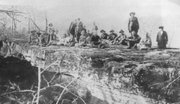CLINTON -- Timid motorists may wish they could turn around as the narrow paved road makes a steep and sinuous descent of nearly 500 feet. But there's really no place to back up. At the bottom, the attraction turns out to be well worth the white-knuckle navigation.
It's Natural Bridge of Arkansas, created by as many as 3 million years of erosion by Little Johnnies Creek in a wooded valley of Van Buren County four miles north of Clinton. It became a commercial attraction in 1969, when two log cabins were moved to the site, along with a covered wagon and other pioneer-era artifacts.
One cabin serves as entrance and gift shop, where visitors pay admission and are greeted by genial owner Jim Smith, who acquired the property four years ago. He is happy to share what is known of the impressive rock formation's history -- and prehistory, when it was well known to Quapaw residents of the area.
An information panel in the cabin describes the bridge as "one of the delicate, parabolic types. It looks as if it was sculpted with mathematical exactness from the brown sandstone bluff. A mere four feet thickness of stone holds the thing together at the center of its arch."
Spanning nearly 120 feet, the formation looks fragile. So it may be surprising to learn that loggers regularly drove their horse-drawn wagons across the bridge in the late 19th century. A photo from a century ago shows more than a dozen excursionists standing or sitting on it.
There's no longer any pedestrian access to the structure, but a short handicapped-accessible trail offers close-up views from below. Picnic tables provide a rustic lunch setting.
A panel recounting the bridge's history reports "indications that a handful of Jayhawks, those robbers that roamed this region during the Civil War, used the rock shelters as sleeping places and the bridge as a shelter for their horses, which they had to keep saddled at all times because residents of the area were constantly trying to capture these dreaded ruffians."
The site's second cabin houses a mini-museum of antiques and memorabilia. Among the 75 items are a cornbread pan, a mole trap, a spinning wheel, a barbed-wire stretcher, a tobacco shredder, a cowboy bathtub and a pea thrasher. Displayed below the cabin is a moonshiner's still.
In the century-old photograph, the natural bridge looks very much as it does today. Smith says the span eventually will collapse, "but not in my lifetime or yours. It's going to be a long, long, long time before that happens."
Natural Bridge of Arkansas is four miles north of Clinton, off U.S. 65. The right turn onto Natural Bridge Road is marked with a sign. The attraction is open 8 a.m.-6 p.m. daily. Admission is $5 for visitors 12 and older, $3 for children 6-11, free for kids 5 and under. Call (501) 745-2357.
Weekend on 04/06/2017

